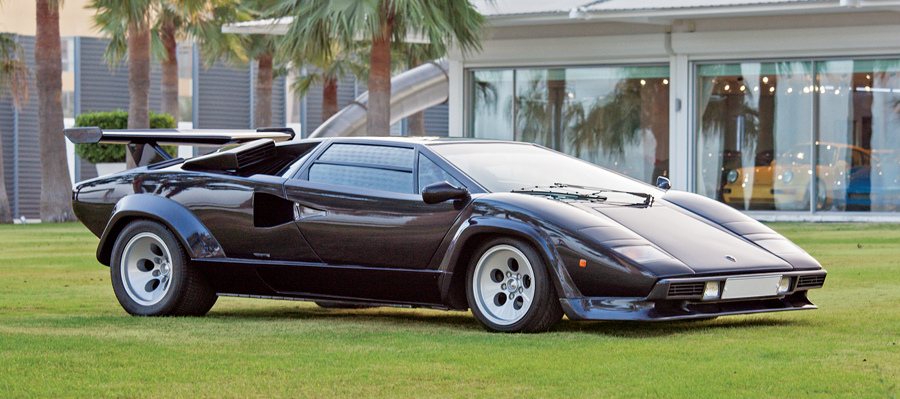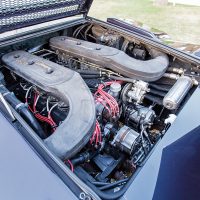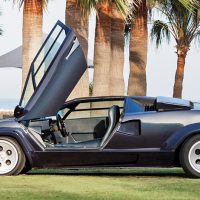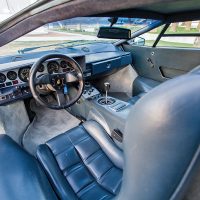SCM Analysis
Detailing
| Vehicle: | 1979 Lamborghini Countach LP400 S Series I |
| Years Produced: | 1978–79 |
| Number Produced: | 50 (LP 400 S Series I) |
| Original List Price: | $41,000 |
| SCM Valuation: | $368,000 |
| Tune Up Cost: | $4,500 |
| Chassis Number Location: | Engine compartment on firewall plate |
| Engine Number Location: | In center of head on top of block |
| Website: | http://www.lamborghiniregistry.com |
| Alternatives: | 1979 Ferrari 512 BB, 1979 Aston Martin V8 Vantage, 1971 DeTomaso Mangusta |
| Investment Grade: | B |
This car, Lot 106, sold for $305,000, including buyer’s premium, at RM Sotheby’s Abu Dhabi, UAE, auction on November 30, 2019.
This month’s subject car brings up a couple of very interesting aspects of the collector-car world.
The first is the reality that all vehicles have a moment of passing from an intended use as transportation of some kind to an object of more abstract appreciation. Even a supercar — meant to be a sunny-day occasional plaything — was built to be driven. How each owner approached that can be revealed in a car’s history.
Day Two
It is common in the American collector-car arena to speak of “Day Two.” If you’re not familiar with the term, it refers to the modifications the first owner made shortly after taking delivery in order to personalize the car. In many cases, those alterations, cosmetic or mechanical, can still be found on the car years later, as it enters “collectible” status.
I can personally recount my actions back in 1986 when I took delivery of my brand-new 1987 Alfa Romeo Milano. In my first month of ownership, I replaced the factory wheels with aftermarket alloys and had an accessory wood-rim steering wheel and gearshift knob installed to replace the factory leather items.
Did I keep the originals? Of course not! Who had room to store them in New York City, where I lived, and besides, what would be the point?
Although I was certainly aware of, interested in and had owned collector cars at that point, the idea that 30 years later someone might actually care that the factory wheels, steering wheel and shift knob had been replaced and that it might lower the value of the car was ludicrous. None of the changes I had made negatively affected the look or driving dynamics of the car — but they increased my aesthetic appreciation.
In the case of the Countach here, an early owner decided that he was unhappy with the decision of the Lamborghini engineering and design team to sacrifice maximum horsepower through the use of side-draft carburetors rather than downdraft carburetors. This factory move “robbed” the LP400 S of 10 hp compared to the Miura SV, which preceded the original LP400 Countach. Despite the fact that the LP400 S featured an increase in torque — the more-usable performance metric, to 285 from 266 ft-lb over the LP400 — it wasn’t enough for him.
Therefore, he decided to have the Miura carburetors installed in his Countach, which, of course, necessitated modifying the engine cover to provide clearance. What that did for the already slightly suspect aerodynamics of the car cannot be said, but also during his ownership the car gained a body kit, rear wing and custom wheels. The last were eventually swapped out for factory items during a fairly recent refurbishment.
Not original and not factory
As per the catalog description, the car has not been restored. The interior is stated to remain original after an exterior respray in the original color.
So the second aspect of collectible choice becomes what, exactly, would potential bidders be seeking when considering this particular car? It’s not original, and unlike many vintage Lamborghinis, which regularly saw their specification updated by the factory when returned for service, the carburetor swap and body modifications are not the work of Sant’Agata.
It’s also not a fully restored example either, meaning that it’s not the car to bring to an international concours d’elegance for carting home trophies. It’s a driver — and in 2019, when the car will be used for general amusement as opposed to 1985, when it would have been pushed to its maximum capability, can anyone actually feel, or more realistically use, any difference in performance that the carburetor change might give?
The answer to both our aspects is that in the end, it’s likely that our subject’s appeal proved limited due to its history and circumstances. Here, the Day Two modifications did not add value, and as has been the case in most live auction transactions of the past four years, this particular channel does not reward cars that sit between “barn find” — or “perfectly preserved” — and “freshly, brilliantly restored.”
It is worth noting that this was something of a “local” car, having been consigned from Middle Eastern ownership to the Abu Dhabi sale. It is quite likely that many potential bidders would have been familiar with the car from its area residency, or the Europeans in attendance on F1 weekend might recall the car from its prior life in Germany and Switzerland.
As few Countaches have been built, the community knows most of them quite well, and it’s unlikely someone new to the model would have sought out such a modified example.
Not a $1 million car
When Countach values rose not many years ago to meet those of the Miura, many saw it as a sign of generational shift. I’ve long been a non-believer in this theory, preferring to look to the constant expansion of the collecting field, which simultaneously is continuously self-editing for quality and importance.
There are still $1 million Lamborghini Countaches abroad in the world. This wasn’t one of them — neither the model nor the example.
Selling as it did below the SCM Price Guide Median Valuation and well below the last auction sales of similar vehicles, I would consider it appropriately traded. The new owner has a car for fun driving — even if it has to be explained every time it is parked. ♦
(Introductory description courtesy of RM Sotheby’s.)





